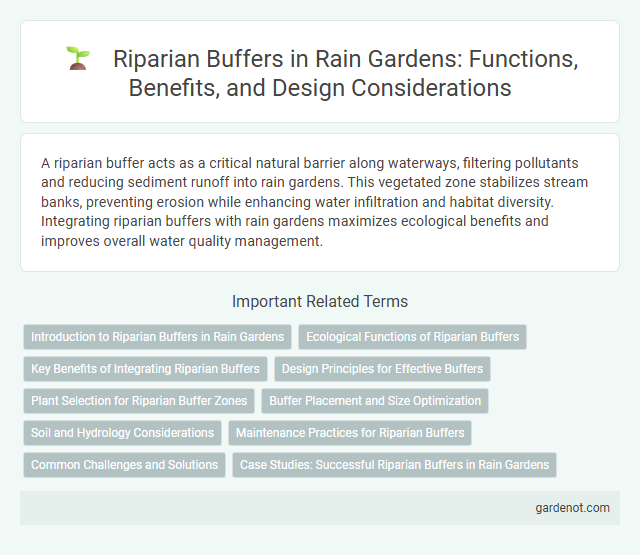A riparian buffer acts as a critical natural barrier along waterways, filtering pollutants and reducing sediment runoff into rain gardens. This vegetated zone stabilizes stream banks, preventing erosion while enhancing water infiltration and habitat diversity. Integrating riparian buffers with rain gardens maximizes ecological benefits and improves overall water quality management.
Introduction to Riparian Buffers in Rain Gardens
Riparian buffers in rain gardens serve as vegetated zones along waterways that enhance water quality by filtering pollutants from runoff before they reach streams and rivers. These buffers stabilize stream banks, reduce erosion, and provide critical habitat for wildlife, promoting biodiversity within the watershed. Integrating riparian buffers into rain garden design maximizes stormwater management efficiency and supports ecosystem health by mimicking natural hydrological processes.
Ecological Functions of Riparian Buffers
Riparian buffers play a critical role in enhancing water quality by filtering sediment, nutrients, and pollutants before they enter aquatic ecosystems, thereby protecting aquatic habitats and biodiversity. These vegetated zones stabilize stream banks and reduce erosion through root systems that absorb water flow energy, which helps maintain soil integrity. Riparian buffers also provide essential wildlife corridors and support habitat connectivity, promoting ecological resilience in riparian and adjacent terrestrial environments.
Key Benefits of Integrating Riparian Buffers
Riparian buffers play a crucial role in enhancing rain garden effectiveness by filtering pollutants, stabilizing soil, and reducing stormwater runoff. They provide habitat for wildlife, improve water quality by trapping sediments and nutrients, and mitigate flood impacts through natural water absorption. Integrating riparian buffers with rain gardens promotes ecosystem health and supports sustainable watershed management.
Design Principles for Effective Buffers
Riparian buffers should incorporate native vegetation with diverse plant species to enhance water filtration and provide habitat stability. Proper buffer width, typically ranging from 30 to 100 feet, is essential to maximize pollutant interception and soil erosion control. Strategic placement along water bodies ensures optimal runoff management and supports ecological balance in rain garden systems.
Plant Selection for Riparian Buffer Zones
Selecting native vegetation such as willows, sedges, and rushes enhances the effectiveness of riparian buffer zones by stabilizing soil and filtering pollutants from runoff. Deep-rooted trees like cottonwoods and alders improve bank stabilization and provide critical habitat for wildlife. Incorporating diverse plant species with varying root depths maximizes water absorption and nutrient uptake, promoting healthier stream ecosystems.
Buffer Placement and Size Optimization
Riparian buffer placement is critical for maximizing water quality improvement and habitat protection, typically positioned along stream banks and wetlands to intercept runoff. Optimal buffer size varies depending on slope, soil type, and vegetation density, with widths ranging from 10 to 100 feet recommended to effectively reduce sediment, nutrient loads, and temperature fluctuations. Research indicates wider buffers enhance pollutant filtration and support biodiversity, making strategic buffer sizing essential for sustainable rain garden integration in riparian zones.
Soil and Hydrology Considerations
Riparian buffers play a critical role in enhancing rain garden effectiveness by stabilizing soil and managing hydrology through natural filtration and water absorption. Well-designed buffers utilize native vegetation to reduce soil erosion, improve infiltration rates, and mitigate surface runoff, maintaining groundwater recharge and reducing flood risks. Optimizing soil texture and organic matter content within riparian zones promotes microbial activity and nutrient cycling, which are essential for sustaining healthy hydrologic function in rain gardens.
Maintenance Practices for Riparian Buffers
Regular maintenance of riparian buffers involves monitoring vegetation health, removing invasive species, and replanting native plants to ensure effective water filtration and habitat stability. Periodic inspections help identify erosion issues and sediment buildup, allowing for timely corrective measures that protect water quality and prevent bank degradation. Proper maintenance sustains the ecological functions of riparian buffers, promoting biodiversity and reducing runoff pollution in adjacent waterways.
Common Challenges and Solutions
Riparian buffers often face challenges such as invasive species invasion, sediment accumulation, and nutrient overload, which degrade water quality and habitat integrity. Effective solutions include planting native vegetation to outcompete invasives, implementing bioengineering techniques to stabilize stream banks, and establishing regular maintenance schedules to manage sediment and nutrient influx. Monitoring buffer width and health supports long-term ecosystem resilience and enhances pollutant filtration efficiency.
Case Studies: Successful Riparian Buffers in Rain Gardens
Case studies of successful riparian buffers in rain gardens demonstrate significant improvements in water quality through reduced nutrient runoff and sedimentation. For example, the Chesapeake Bay Program reports that well-established riparian buffers can filter up to 90% of nitrogen and phosphorus before they enter waterways. In Minnesota, urban rain gardens with integrated riparian vegetation have led to a 40% decrease in stormwater pollutants, showcasing the effectiveness of native plants in stabilizing soil and supporting aquatic ecosystems.
Riparian buffer Infographic

 gardenot.com
gardenot.com